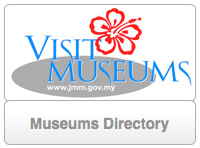
INTRODUCTION
The Perak Museum was built in 1883 and is the first museum in Malaysia. By year 2013, it is already 130 years old. The Building is unique from the architectural aspect with Indian ‘Moorish’ architecture apart from ‘Neo-classical’ and ‘Victorian’ influence from Europe. It is designed by an English architect.
OBJECTIVE
1. To inform the public regarding the early history on the establishment of the museum.
2. To disseminate information on the development and setting up of museums at large.
3. To create awareness to the public on the importance of preserving heritage and culture of the country.
4. To attract more visitors to the museum.
5. To cultivate interest and love in museums.
HISTORY OF ESTABLISHMENT
The idea to set up the Perak Museum was mooted by Sir Hugh Low, third Resident of Perak State. He felt it necessary to set up a museum to function as a research and collection centre for the country’s history, cultural and natural historical. His aim is to study and to understand the local way of life. He appointed Leonard Wray Jr., who is a botanist and geologist to collect plant and insect specimens as the earliest collection of the Perak Museum.
BUILDING RESTORATION
In view of the age of the building which is 130 years old, there exist many structural damage to the building. Therefore, restoration of the building was carried out in stages starting from November, 2007 till March, 2009.
Phase I - Gallery C & D (9th November 2007 - 18th April 2008)
Phase II - Gallery A, Library & Artifacts Storage (23rd Jun 2008 - 22ndOctober 2008)
Phase III - Gallery B (23rd October 2008 - March 2009)
GALLERY UPGRADING WORKS
In this modern age, the Perak Museum has upgraded the gallery exhibits and facilities. The upgrading works included display, lighting, information signage and multimedia presentation. This upgrading exercise enhanced the image of the museum to attract more visitors. However, this upgrading works did not change the existing showcases of the exhibits which in itself an artifact that needed to be preserved.
Phase I – Gallery D (2009)
Phase II – Gallery C (2010)
Phase III – Gallery B (2011)
Phase IV – Gallery A (2012)
Phase V – Library and Outdoor Exhibit (2013)
ACTIVITIES
Besides the permanent exhibits, the museum holds temporary or mobile exhibition with activities to promote the museum and educate the public. The activities such as forum, workshop,quiz, museum explorace, etc. These programmes involve Government Agencies, Non-Government Organizations, Academic Institutions, Cultural Organizations and individuals from all walks of life. The aim is to create a network and bring the museum closer to the community.
ACHIEVEMENT
Since the establishment, the Perak Museum has gained recognition from several government and non - government agencies. This has encouraged the Perak Museum to achieve greater heights. Some of the achievements are as follows:-
- In the year 2000, won the Taiping Heritage Building Award in conjunction with Taiping Municipality Day.
- In the year 2003, receiving recognition from Malaysia Book of Records for created the Longest Twin Bicycle.
- In the year 2004, won the Best Decorated Building Award for Public Building in conjunction with the 47th Independence Celebration.
- On 14th February 2009, the Perak Museum was declared as a National Heritage Site (category : building) by ministry of Unity, Culture, Arts and Heritage, Malaysia.
CONCLUSION
Great effort has been taken to ensure that the building continues to flourish and remained as a pioneer museum institutions in the country. Perak Museum has progressed since its establishment. The latest statistics from the Department of Museum Malaysia currently shows that there are 21 museums under its jurisdiction. However, there are 88 museums under the state government, 34 under academic institution and government departments and 10 private museums. This scenario proves that Malaysians are now more aware of the importance to preserve national heritage and culture.
 Printer-friendly version
Printer-friendly version- 6292 reads




